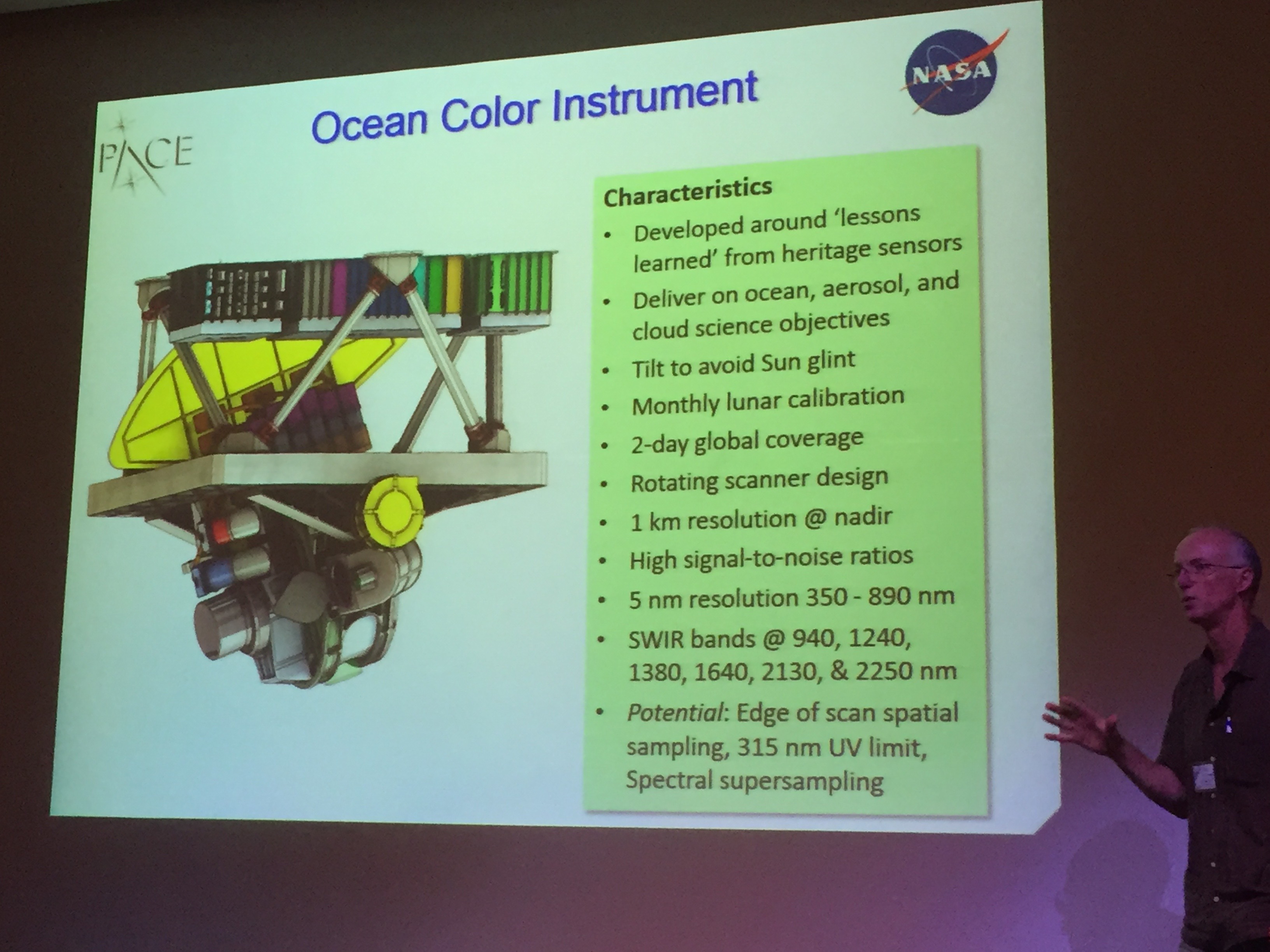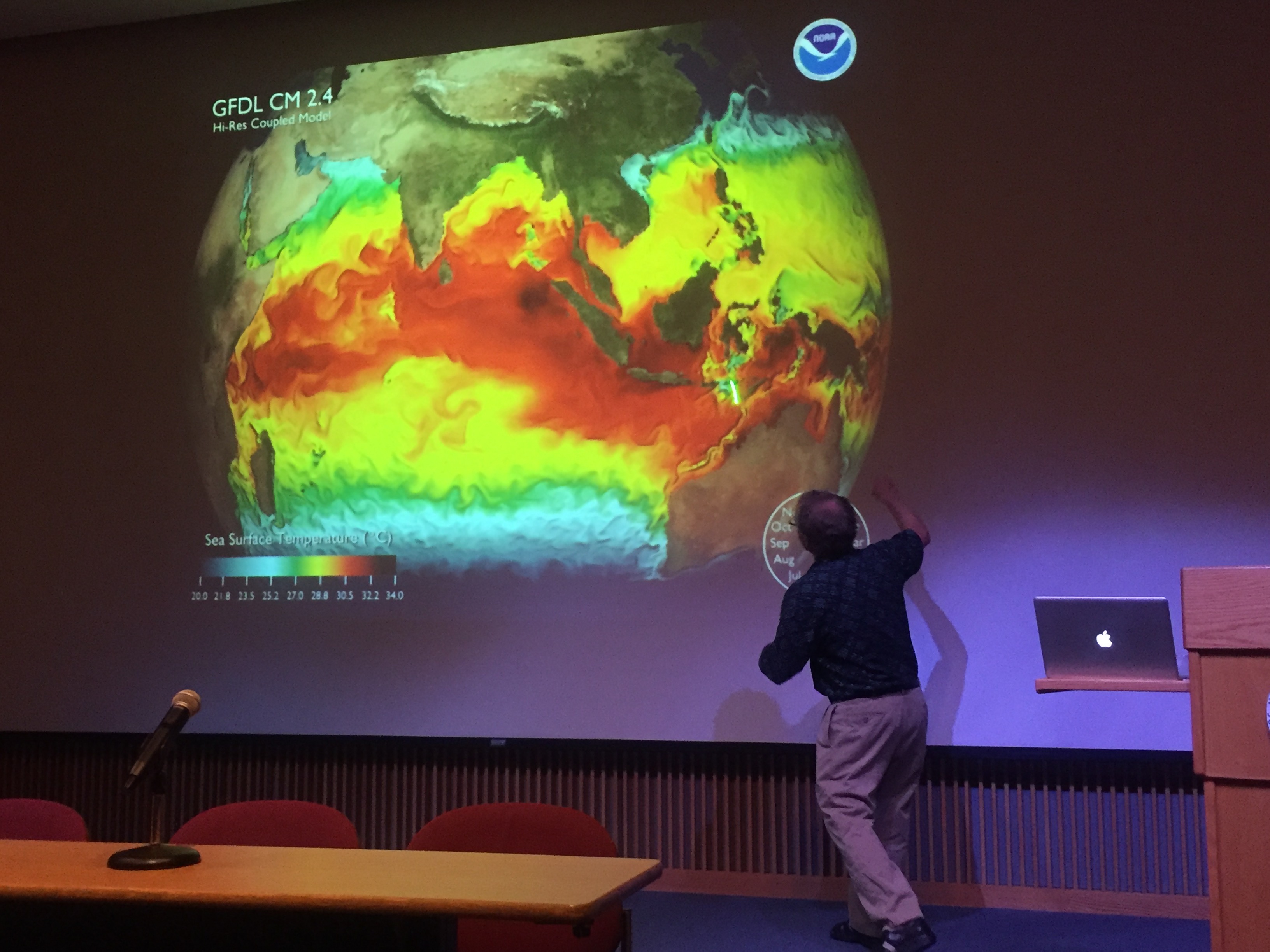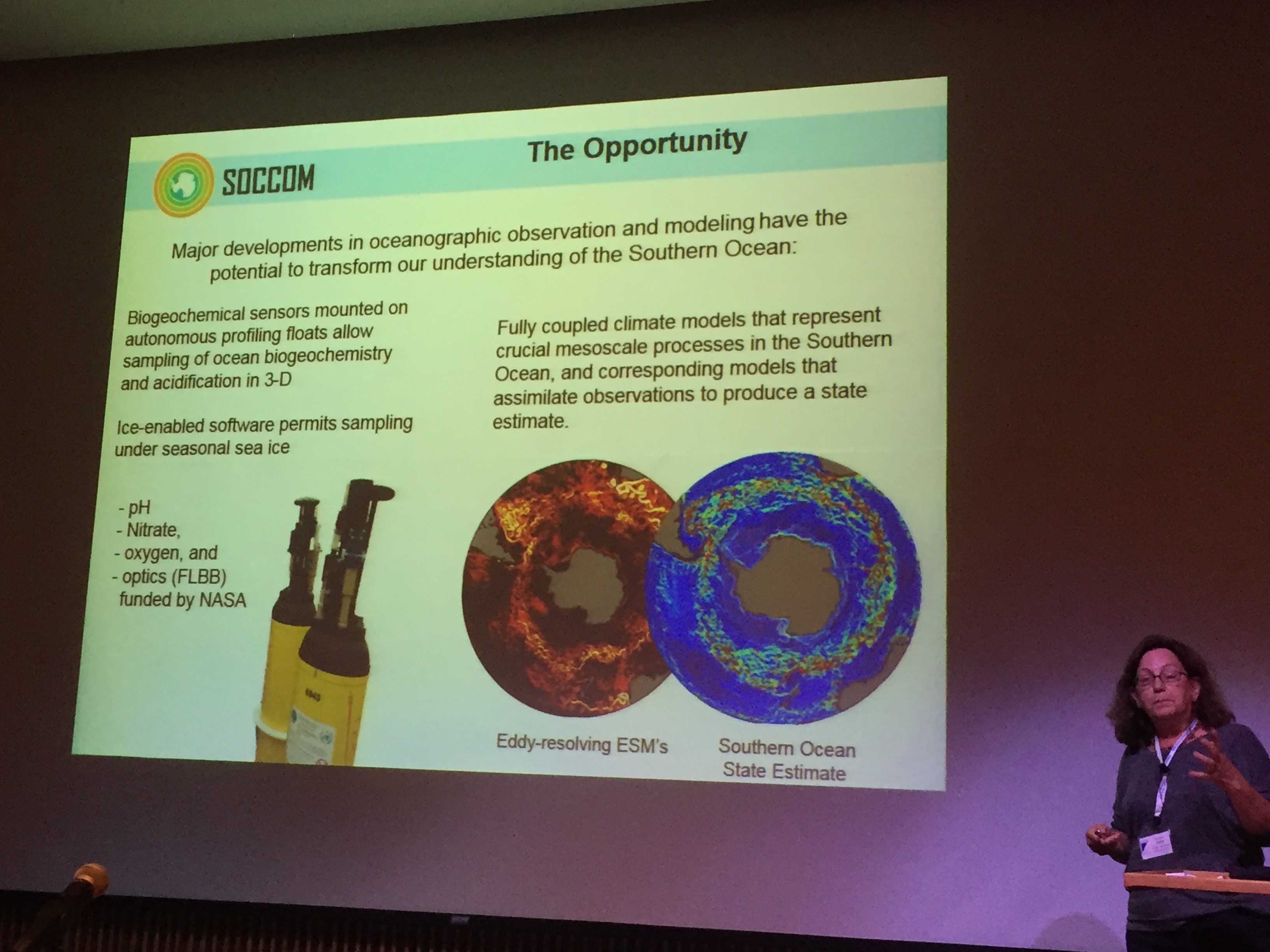The 11th annual Ocean Carbon & Biogeochemistry summer workshop, sponsored by NSF and NASA, convened 186 participants from July 25-28, 2016 at the Woods Hole Oceanographic Institution in Woods Hole, MA.
This year’s summer workshop featured the following six plenary sessions:
Plenary 1. EXport Processes in the Ocean from RemoTe Sensing (EXPORTS)
Plenary 2. The biology of carbon export – New processes and approaches
Plenary 3. Recent advances in quantifying ocean carbon uptake
Plenary 4. Quantifying ocean carbon, oxygen, and nutrient cycles
Plenary 5. The Indian Ocean – Monsoon-driven biogeochemical processes
Plenary 6. Marine ecosystem thresholds and regime shifts
Day 1 kicked off with a presentation on the projected instrumentation and scientific capabilities of the NASA Plankton, Aerosol, Cloud, and ocean Ecosystems (PACE) Mission, which segued into the first plenary session on the proposed NASA EXport Processes in the Ocean from RemoTe Sensing (EXPORTS) field campaign. Speakers in this session provided an overview of both the EXPORTS Science Plan and the Implementation Plan. The session also featured three scientific overview talks on the EXPORTS science questions, the first of which highlighted the influence of ecosystem characteristics such as plankton community structure on organic matter export from the euphotic zone. The second talk focused on key processes in the mesopelagic zone that affect vertical transfer of organic matter to depth.
 The third talk focused on how data generated by EXPORTS will reduce uncertainties in current and future estimates of export, including an overview of current modeling capabilities for different export pathways. The second plenary session of Day 1 was convened by organizers of a recent NSF workshop and white paper on novel biological processes and pathways regulating organic matter export and degradation. Speakers in this session explored potential contributions of mixotrophs, marine microgels, and episodic events (e.g., jelly falls) to biological pump function, and provided an overview of our current observational capacity to quantify carbon export and monitor changes in the biological pump over a range of temporal and spatial scales. The plenary session closed with a community-sharing presentation describing the Carbon Flux Explorer, an autonomous float that can quantify and photograph particulate carbon fluxes. After the plenary sessions, graduate students provided short presentations about their research interests and then all participants convened for a welcome reception and poster session.
The third talk focused on how data generated by EXPORTS will reduce uncertainties in current and future estimates of export, including an overview of current modeling capabilities for different export pathways. The second plenary session of Day 1 was convened by organizers of a recent NSF workshop and white paper on novel biological processes and pathways regulating organic matter export and degradation. Speakers in this session explored potential contributions of mixotrophs, marine microgels, and episodic events (e.g., jelly falls) to biological pump function, and provided an overview of our current observational capacity to quantify carbon export and monitor changes in the biological pump over a range of temporal and spatial scales. The plenary session closed with a community-sharing presentation describing the Carbon Flux Explorer, an autonomous float that can quantify and photograph particulate carbon fluxes. After the plenary sessions, graduate students provided short presentations about their research interests and then all participants convened for a welcome reception and poster session.
Day 2 opened with agency updates from NSF, NASA, and NOAA representatives. Speakers in plenary session 3 then described data- and model-based approaches for studying internal variability (interannual to decadal) and anthropogenic change in ocean carbon uptake, and explored the role of physical processes (e.g., subduction, mesoscale and submesoscale processes, etc.) in modulating ocean carbon uptake. A presentation on the Coupled Model Intercomparison Project (CMIP) provided an overview of CMIP5 simulations of the ocean carbon cycle and how well these simulations reproduce anthropogenic CO2 uptake and natural variability in ocean CO2 associated with the biological pump. To provide a broader range of spatial and temporal perspectives, the session included talks on land-ocean exchanges of dissolved carbon across coastal, estuarine, wetland, and riverine systems and differences in ocean carbon storage during the last ice age, as constrained by paleo-proxies of ocean ventilation and deep-sea oxygen concentrations. This session concluded with a community-sharing presentation on Carbon Hot Spot, a nascent process study to characterize biophysical interactions and quantify ocean carbon uptake in Western Boundary Current regions such as the Kuroshio Extension.
During the afternoon of day 2, speakers in plenary session 4 provided an overview of the Southern Ocean Carbon and Climate Observations and Modeling (SOCCOM) project and newly emerging seasonally resolved ocean carbon data sets from biogeochemical sensor-equipped Argo floats, which are providing unprecedented constraints on wintertime air-sea CO2 dynamics in the Southern Ocean. The session concluded with a presentation on the rationale and plan for a global biogeochemical observing network based on Argo floats equipped with biogeochemical sensors to more effectively monitor changing ocean conditions. Immediately following the plenary session, communication professionals from COMPASS led interactive communication training workshops to help participants share their science across a broad range of audiences using various tools, outlets, and communication strategies. Participants reconvened in the evening hours for the inaugural OCB ocean festival, featuring recent documentaries on the Palmer LTER in Antarctica and the CARIACO time-series.
 After a morning poster session on day 3, participants enjoyed a presentation and Q&A session on the 2015 UN Climate Conference in Paris. Then speakers in plenary session 5 delivered a series of talks on the complex physical oceanographic and climatic drivers that influence biogeochemistry and biological processes in the Indian Ocean, where scientists are amidst planning for the second International Indian Ocean Expedition (IIOE2). The session opened with an overview presentation on key physical oceanographic features and observing resources in the Indian Ocean. Speakers then addressed links between physics, climate, and biogeochemical processes such as dissolved organic carbon (DOC) distribution and dynamics, iron limitation, trace metal cycling and measurements from GEOTRACES, nitrogen fixation, and oxygen deficiency in different parts of the basin and associated effects on biology. The final presentation of the session focused on seasonally variable Indian Ocean boundary currents and their impacts on local ecology and biogeochemistry. Day 3 wrapped up with a presentation by the new US SOLAS (Surface Ocean Lower Atmosphere Study) representative to initiate discussion and brainstorm ideas to facilitate scientific exchanges and new collaborations on topical areas of interest to both OCB and SOLAS.
After a morning poster session on day 3, participants enjoyed a presentation and Q&A session on the 2015 UN Climate Conference in Paris. Then speakers in plenary session 5 delivered a series of talks on the complex physical oceanographic and climatic drivers that influence biogeochemistry and biological processes in the Indian Ocean, where scientists are amidst planning for the second International Indian Ocean Expedition (IIOE2). The session opened with an overview presentation on key physical oceanographic features and observing resources in the Indian Ocean. Speakers then addressed links between physics, climate, and biogeochemical processes such as dissolved organic carbon (DOC) distribution and dynamics, iron limitation, trace metal cycling and measurements from GEOTRACES, nitrogen fixation, and oxygen deficiency in different parts of the basin and associated effects on biology. The final presentation of the session focused on seasonally variable Indian Ocean boundary currents and their impacts on local ecology and biogeochemistry. Day 3 wrapped up with a presentation by the new US SOLAS (Surface Ocean Lower Atmosphere Study) representative to initiate discussion and brainstorm ideas to facilitate scientific exchanges and new collaborations on topical areas of interest to both OCB and SOLAS.
 The final day of the workshop opened with a presentation on the proposed NASA field campaign Arctic-COLORS. The Arctic-COLORS science plan is undergoing revisions, so authors were seeking input from the OCB community. The final plenary session of the workshop, plenary 6, featured a series of talks on marine ecosystem thresholds and regime shifts. In this session, speakers explored phytoplankton response to natural climate variability and anthropogenic climate change (phenology, biogeography, community composition, etc.), implications of climate-driven changes in bloom phenology for higher trophic levels, ecological changes and associated shifts in benthic communities of the Pacific Arctic, and the development of tools such as early warning systems to identify and predict nonlinear shifts in ocean ecosystems. A separate 1.5-day meeting on Arctic-COLORS immediately following the OCB workshop provided an opportunity for more in-depth discussions and opportunities to gather feedback.
The final day of the workshop opened with a presentation on the proposed NASA field campaign Arctic-COLORS. The Arctic-COLORS science plan is undergoing revisions, so authors were seeking input from the OCB community. The final plenary session of the workshop, plenary 6, featured a series of talks on marine ecosystem thresholds and regime shifts. In this session, speakers explored phytoplankton response to natural climate variability and anthropogenic climate change (phenology, biogeography, community composition, etc.), implications of climate-driven changes in bloom phenology for higher trophic levels, ecological changes and associated shifts in benthic communities of the Pacific Arctic, and the development of tools such as early warning systems to identify and predict nonlinear shifts in ocean ecosystems. A separate 1.5-day meeting on Arctic-COLORS immediately following the OCB workshop provided an opportunity for more in-depth discussions and opportunities to gather feedback.
For more information, including links to plenary talks and webcast footage, please visit the workshop archive page or contact Heather Benway.




